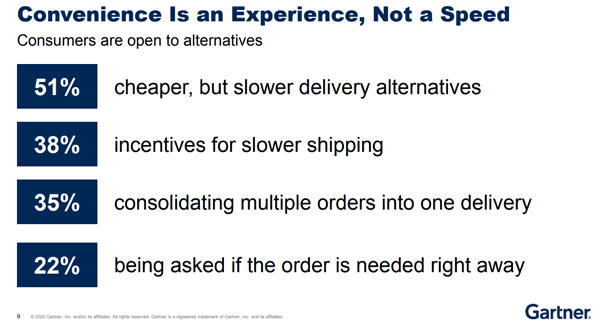Among the huge surge of parcel shipments in this Christmas season, with volumes expected to rise as much as 40% and UPS and FedEx refusing to take some shipments from retailers that have blown past their earlier forecasts, some retailer are pushing customers to consider slower deliveries.
For now, such moves seem entirely about cost savings and reducing parcel network congestion. But increasingly, retailers need to make similar moves in support of sustainability, says Gartner analyst Tom Enright.
Supply Chain Digest Says...
|
 |
| Enright said a growing number of consumers seeing a single package delivered to their homes are asking if that shipping approach is causing environmental damage |
 |
What do you say? |
| Click here to send us your comments |
|
 |
| Click here to see reader feedback |
|
Even Amazon.com, which pulled the world's supply chain towards ever faster deliveries, from two days to one day to same day, is jumping a bit on the "slower is (sometimes) better" bandwagon.
According to the modernretail.com web site, Amazon is encouraging customers to pick up items in-store at an Amazon Books location if one is nearby, bundling orders into a single-day delivery called an "Amazon Day" or, in exchange for a discount, opting for no-rush shipping.
Amazon isn't the only one.
Macy's and Target have each offered no-rush incentive options this year. Macy's is said to have at times offered $10 off in exchange for selecting no-rush shipping.
Timberland recently launched its own form of incentive, but in lieu a direct financial benfit, Timberland said it would plant a tree for every no-rush selection.
Even though Walmart recently eliminated its cost minimum for free next-day delivery, it also appears to be upping the incentives for slow delivery, or pick up in store.
Modern Retailing says this might indicate a “changing mindset for some retailers - rather than focusing on speed at all costs, some are taking a more nuanced approach to logistics. They'll still rush-ship the items that need to be in by the holidays, but to offset that cost, they want the non-urgent items to wait.”
Looking again at Amazon, unknown to many it has offered a no-rush delivery option for approaching 10 years. But in 2020, it decided to make the incentives more appealing, raising the value to as much as $3.00 from $1-2.00 previously.
Amazon also streamlined the way it handles those incentives. Before, used a complicated credit system that required customers to buy more items in order to spend their credits. Amazon now subtracts the $3 from the item's cost - making it much more appealing.
(See More Below)
|
CATEGORY SPONSOR: SOFTEON |
|
|
| |
|
|
Meanwhile, Gartner analyst Tom Enright says a significant and rapidly growing segment of retail customers care more about sustainability than fast shipping – at least some of the time – and that retailers are not doing enough to support those customers with different shipping alternative.
Speaking recently at Gartner's virtual Supply Chain Executive Symposium, Enright asked attendees "What if you found out customers care more about the environment than you do?"
Customers are in fact rethinking how they engage with retailers, and how they purchase products.
Historically, consumers made decisions based on three factors, Enright said: convenience, cost and speed. In the ecommerce era, he added, many have simply equated convenience with fast delivery.
But that isn't really accurate, Enright said - many consumers would be happy with ordering now and receiving the order many days later, even if the order process was convenient.
In fact, Enright says sustainability is fast becoming a key fourth factor in how consumers will make buying decisions - and for many will in fact be the most important factor.
He said a growing number of consumers seeing a single package delivered to their homes are asking if that shipping approach is causing environmental damage. Maybe they would rather have their orders consolidated with those of their neighbors, and have more sustainable delivery options offered by retailers. Consumers, he says, are asking how sustainable a retailer's shipping methods really are.
Enright cautions that certainly not all or even most consumers are thinking this way now, but that this sentiment is growing at such a pace that retailers cannot afford to ignore it.

As a result, Enright says retailers need to focus on three things: (1) Offering more sustainable shipping options, generally meaning slower deliveries; (2) Focus on using recyclable and even reusable packaging; and (3) Embracing "recommerce" - basically the sale of used merchandise, especially in apparel.
It will be interesting to see in Enright's perspective gains real traction – or if the consumer's demand for speed continues to mostly trump all else.
Do you think slow shipping will really catch on? Let us know your thoughts at the Feedback section below.
|